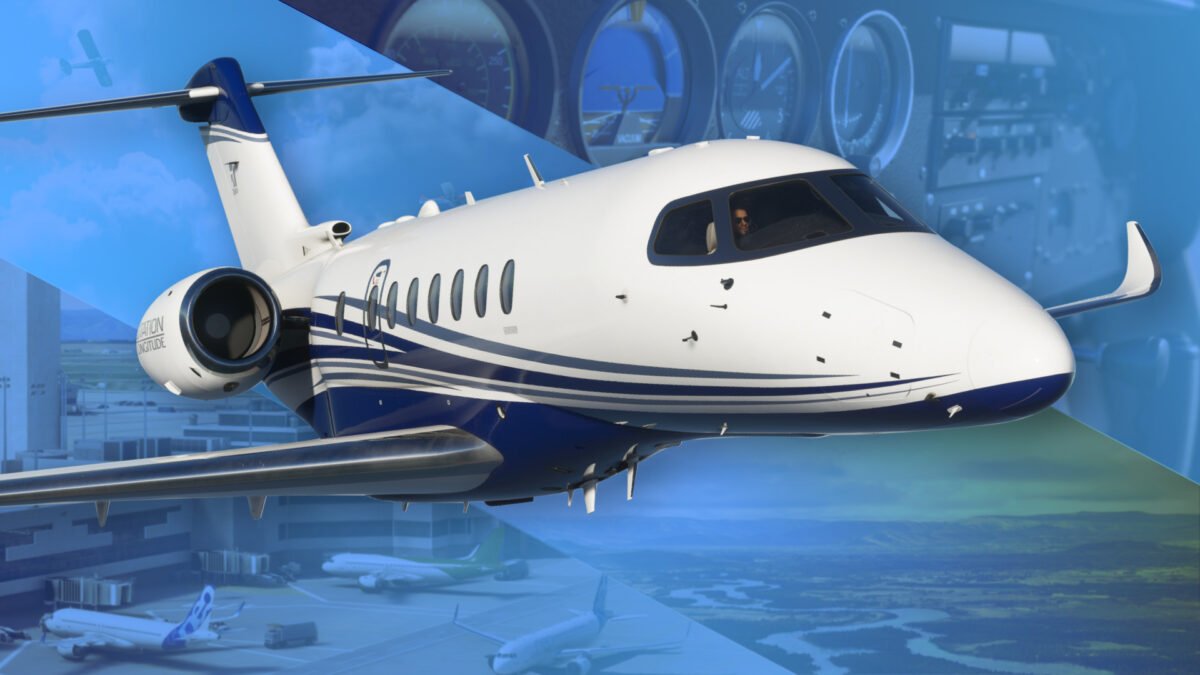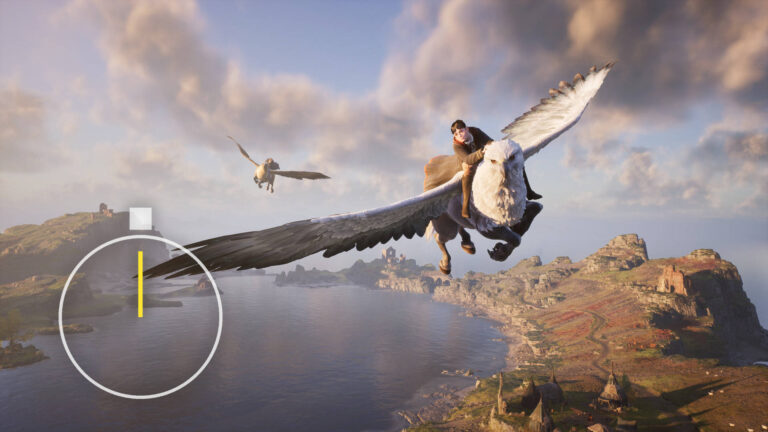Flight Simulator 2020 is a stunning flight simulation game using a unique, superior and groundbreaking technology to visualize the real world. We will introduce you to the basics of flying and take you safely into the virtual air for the first time.
- Blue or different-colored bars with a double arrow symbol include texts and sometimes tables, which are folded for clarity. Click or tap on the bars to open them. When using mobile devices, slide your finger to the left to fully view the tables.
In this guide we will show you
- whether the FS2020 is suitable for you and where you can buy the different versions of the game
- which PC system requirements you have to fulfill and which type of installation may be suited for you
- which types of aircraft you can fly at the beginning
- whether Flight Simulator 2020 supports Virtual Reality
- whether there are mods and add-ons
- how to approach the first flight step-by-step
- a detailed overview the cockpit structure
- and what background information a prospective pilot should know.
- Attention: This guide has a claim on completeness and will therefore be continuously expanded and updated.
FS2020: Versions, System Requirements, Installation, VR, XBox & more
What is Flight Simulator 2020?
- FS2020 is an impressive and highly complex flight simulation game that aims to represent the world of flying as realistically as possible.
The first version of Microsoft Flight Simulator was released in 1982, almost 40 years before the current version. Flight Simulator used to be developed by Bruce Artwick and his company SubLogic in the late 1970s. Microsoft acquired the rights in 1982.
The beginnings of PC-supported flight simulation seem prehistoric from today’s point of view, since the graphics consisted only of a few vector lines (which is the reason why they are also called vector graphics). Considering that only four colors were displayed, this is of course no comparison to today’s TrueColor 3D textures and graphics (including shadows, fog and various light calculations). The remarkable development from the first to the current flight simulation is vividly demonstrated in the attached video “Evolution of Microsoft Flight Simulator 1982-2020”. We recommend this video particularly for the younger ones amongst you. After all, you – unlike us – did not have the chance to live through these phases of development.
Under no circumstances should one dismiss the beginnings of flight simulation. On the contrary, one should appreciate every single step of development and regard it as a necessary step towards the ability to experience and enjoy the current state of Flight Simulator.
Back to the present! Maybe you’d like to get a first impression of the current stage of Flight Simulator development through this official trailer.
S4G-Review for Flight Simulator 2020
The FS2020 is right for you, if …
- you are enthusiastic about flying and want to fly the world from the perspective of a pilot,
- you enjoy seeing known and unknown landscapes from a bird’s eye view,
- you find real simulations about everyday life appealing,
- the complex operation of up to 50 instruments and switches will not discourage you,
- you are willing to learn and are not afraid to look at a professional article or tutorial alongside playing, and if
- you are in the preparation phase for obtaining the PPL (Private Pilot License).
The FS2020 is not suited for you, if …
- you do not have an appropriately capable PC with Windows 10 (1909) or an Xbox Series X console,
- you prefer to fly military aircraft or a helicopter or gyrocopter
- you are interested in flying, but you do not have enough time and patience, and if
- your English isn’t very good (this is important for people who are not native speakers of English) and are not a fan of abbreviations.
What are the PC-System Requirements for Flight Simulator 2020?
- Minimum (Microsoft)
Processor: Core i5-4460 or Ryzen 3 1200
Graphics card: Geforce GTX 770 or Radeon RX 570 with 2GB video memory
RAM: 8 GB
DVD/Download: 150 GB
Hard disk type: HDD
Internet Speed: 5 Mbps - Recommended (Microsoft)
Processor: Core i5-8400 or Ryzen 5 1500X
Graphics Card: Geforce GTX 960M or Radeon RX 590 with 4GB video memory
RAM: 16 GB
DVD/Download: 150 GB
Hard disk type: HDD
Internet Speed: 20 Mbps - Editorial recommendation (for a complete simulation experience with potential for the future)
Processor: Core i9-10900K or Ryzen 9 3950X with a future-proof motherboard for future CPUs
Graphics Card: Geforce RTX 3080 or Radeon RX-5700 XT with min. 12 GB video memory or (better) more
RAM: 32 GB RAM or (better) more
DVD/Download: 200 GB (Caches, Premium Version AddOns, Patches)
Hard disk type: SSD PCI (No SATA SSD) with 500 GB free installation space or (better) more
Internet Speed: 50 Mbps or (better) more
Hardware: Joystick/yoke with throttle and preferably also with rudder pedals
- Professional tip 1: Microsoft specifies the installation size as 150 GB for the Premium version. But with the div. cache memory you definitely need more free space. You should expect at least 200 GB for the standard installation. With the permanently added patches and AddOns/Mods, 500GB are much more realistic in the mid to long term.
- Professional tip 2: Even though the recommended memory size is 16 GB, we strongly recommend at least 24 GB as minimum. This is simply because the FS2020 is rarely used without parallel applications and AddOns/Mods.
- Professional tip 3: If you want to fly Flight Simulator 2020 passionately and for a long time, and also want to use the full power of the simulator, you should aim for the PC version in a similar hardware configuration as in the editorial recommendation above. The Xbox Series X variant will hardly be able to show the full potential of FS2020.
Where can I buy the FS2020 and which Versions can I choose?
- FS2020 is available on Steam, in the Microsoft Store, or as online or offline installation in retail stores , and also at Amazon.
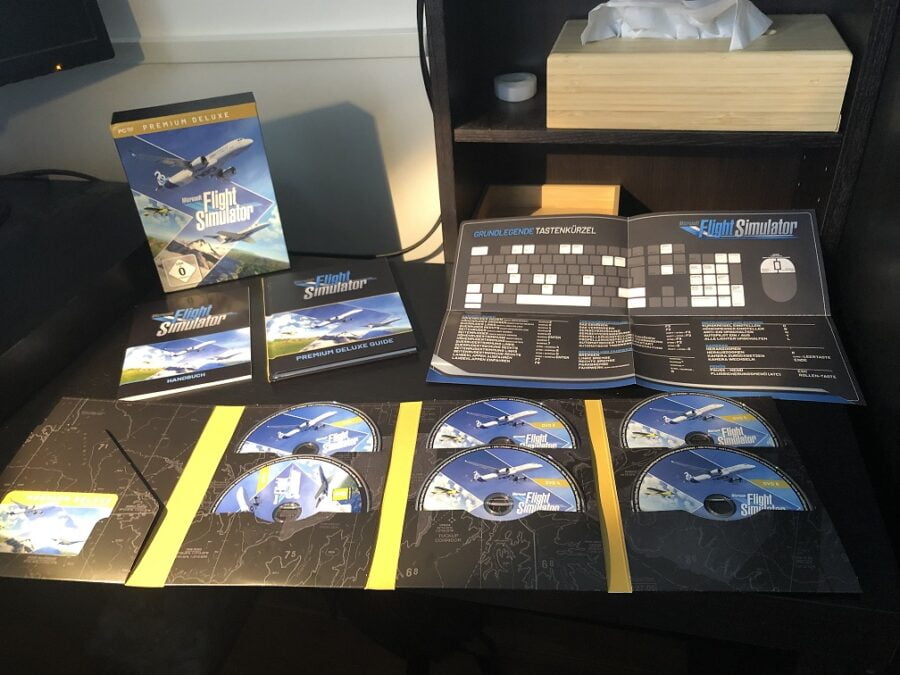
Microsoft distinguishes between three versions: Standard, Deluxe and Premium Deluxe. They differ in scope in terms of additional airfields (handmade) and aircplanes. For example, only the Premium version includes Frankfurt Airport (ICAO:EDDF) and the airliner model Boeing 787-10 Dreamliner.
Which Type of Installation is suited for me?
There are basically two types of installations for FS2020: the online and the “offline” installation. In the latter case, you have the possibility to install the simulator via DVDs (if you choose the boxed version).
- The “offline” version installs only the data of the standard version of Flight Simulator 2020 from a set of ten DVDs. The premium content (airplanes and airports) is unlocked online via a code (included in the box).
Due to the high amount of data, an online installation is not advisable, especially when you suffer from a rather unstable internet connection. You will have independence with the box-version. You will notice that at the latest, when you need to re-install your computer or the Flight Simulator. It also gives you something to hold in your hands and provides you with a printed keyboard plan as well as manuals for basically the same price!
- Even if the installation data does not need to be downloaded during the offline installation, you will still need an internet connection. Flight Simulator 2020 also requires you to be connected to the internet for the actual game itself.
- The installation time for the online and boxed version is about the same and can last several hours.
- After a new installation, you may have to download a lot of patches in the high GB range (well over 20 GB) again.
Instability of the first FS2020 Version
- The first version of Flight Simulator 2020 (first release including the first patches from October 2020) tends to crash frequently (Crash to Desktop). In addition, some functionalities, such as the sensitivity settings for various input devices (keyboard, mouse, joystick, etc.) disappeared because of the latest patches. If you keep the other problems in mind, one could easily conclude that the stability leaves a lot to be desired. Despite this, the quality of the simulation game is already of high quality though – at least in the area of world representation.
We gathered our impressions of Flight Simulator 2020 on the following hardware: Intel Windows (1909) PC with i7-9700K processor, RTX 2070 Super and an Asus Rog Strix mainboard with 32 GB memory. Among other things, there seems to be an out-of-memory problem with the graphics card memory. The existing 8 GB of the RTX 2070 Super seem to be fully occupied until shortly before the game crashes. The crashes can be reduced or even eliminated by switching from “Ultra” to “High” in the graphics settings. It is to be assumed that Microsoft will solve this problem with one of the upcoming patches.
- Most airplanes, with the exception of the Cessna models, are limited in their full functionality!
The limited system depth is apparent in the fact that, for example, many cockpit switches are not (yet) operable or their instruments are not (yet) functional. Here, too, we assume that Microsoft will help with patches over time.
- Most airplanes, with the exception of the Cessna, don’t fly very realistically!
Especially in the case of the Airbus A320neo, experts will notice that the systems and control inputs do not lead to a realistic fly-by-wire experience. But even simple autopilot inputs can end in outlandishly spectacular flight maneuvers. Moreover, the physical motion behavior of a 70-ton object like the A320neo is rather questionable. The large mass moments of inertia (around all three flight axes) ensure a high inertia during control inputs in purely physical terms. At present, the promised flight physics model does not seem to be fully developed, or the many subtleties such as aerodynamic damping as well as the ground effect do not seem to be implemented correctly.
We expect improvements via patches in this area, too.
- Micro Stuttering!
Unfortunately, Flight Simulator 2020 tends to suffer from frequent and significant micro stuttering. This can impair the simulation experience, especially when you are in critical flight phases like the landing.
Technologies which can significantly reduce this behavior, such as the low-level graphics API (Application Programming Interface) Vulkan, already exist. Microsoft could catch up with the competition and use the already existing DirectX12 API for FS2020. It can be assumed that Microsoft will improve this situation under DirectX11 as well.
Flight Simulator 2020: Can I also fly in VR?
- VR support is planned for the PC version in the near future, and is even in the beta phase at the moment. But for the beginning, only the VR-glasses HP Reverb G2 will be supported.
To play Flight Simulator in VR, it is important to have a correspondingly clear and high resolution, that ensures that you can read the important instruments and displays without any effort. The HP Reverb G2 (Infos, German) with a resolution of 2,160 x 2,160 pixels and a field of view of about 114 degrees offers a very good basis for using VR with Flight Simulator 2020. More VR glasses (Comparison, German) will follow later.
We are planning our own guide about this topic, which will introduce you to the special features of Flight Simulator 2020 in VR.
Will the FS2020 be released for PS4 and Xbox One?
- The Flight Simulator 2020 will be released for the Xbox Series X and will also be available for the much weaker XBox One. Dates for a release of FS2020 on consoles are still missing though.
Even if the FS2020 will be playable on the upcoming Xbox Series X, you should still, if possible, play the FS2020 on a powerful PC – especially if you want to use VR or hardware like a HOTAS system. The Xbox hardware probably can’t fully utilize the potential of the FS2020, which is likely to have a negative effect on the graphical splendor of the world presentation.
Which Airports can I fly to in Flight Simulator 2020?
Basically you can fly to all airports that exist in the world. However, some airports are not accessible for unknown reasons. Stuttgart Airport (ICAO:EDDS), for example, is not available. But the community is already working on solutions and some missing airports are offered in the form of mods (some of them cost money though). Commercial solutions can often score here with higher quality, but you should still check the numerous free offers (freeware) before buying (especially if specific missing airports are rarely approached).
- Airports are identified with the so-called ICAO Code, which consists of four letters. The ICAO is the world’s central aviation organization which, in addition to airport codes, also sets worldwide standards for civil aviation, and is therefore considered the world’s highest authority for air traffic.
- You can get an overview of airports using our interactive tool Flight Simulator 2020: Airports with map & all game editions.
Which Airplanes can I fly in Flight Simulator 2020?
Below we have listed the in-house FS2020 airplanes that are available in the three versions Standard, Deluxe and Premium.
- Additional and improved airplane types (i.e. with higher system depth) will be offered for purchase or as freeware by third parties in the future. However, this may take some time, especially with the top quality providers.
- You can get an overview of the aircrafts in our tool Flight Simulator 2020: Aircraft and data.
Overview: Airplane Types
| Type | Operation Area | Examples of known samples / manufacturers | FS2020 (S)-Standard, (D)-Deluxe, (P)-Premium |
|---|---|---|---|
| Jet | Airliner Business Military | Boeing 737 / 747 / 777 / 787 Airbus A320-Family (A318/A319/A321) Dassault Falcon Learjet Cessna Citation Eurofighter | Airbus A320neo (S) Boeing 747-8 Intercontinental (S) Boeing 787-10 Dreamliner (P) Cessna Citation CJ4 (S) / Citation Longitude (P) |
| Turboprop | Airliner Business Military | ATR 42 Bombardier Dash 8 Pilatus PC12 Airbus A400M | Daher TBM 930 (S) Beechcraft King Air 350i (S) / Baron G58 (D) Cessna 208 B Grand Caravan (S) |
| Propeller | Business Sports Private Training Historical | Beechcraft Baron Extra 300 Cessna 152 Piper PA-44 Kitty Hawk (Wright brothers) | Aviat Pitts Special S2S (S) Cirrus SR22 (D) Cub Crafter XCub (S) Diamond DA40 NG (D) / DA40 TDI (D) DA62 (S) / DV20 (D) Extra EXTRA 330LT (S) Flight Design CTSL (S) ICON A5 (S) JMB Aircraft VL-3 (S) Pipistrel Virus SW121 (D) Robin Cap10 (S) / DR400 Cadet (S) Beechcraft Bonanza G36 (S) Cessna 152 (S) / 152 Aerobat (D) 172 Skyhawk (D) / 172 Skyhawk G1000 (S) Savage Cub (S) / Shock Ultra (P) |
| Sail / Glider | Historical Sports Private | Normalsegelapparat (Otto Lilienthal) Nimbus 3 Schleicher ASW 12 | not available |
| Helicopter | Historical Sports Private Military | Bell UH Huey BO 104 Robinson R44 NH90 | not available |
- FS2020 can only be used to fly civil and motorized airplanes with wings (Fixed Wing Airplanes). Military aircraft, helicopters and gyrocopters, sailplanes, re-entry vehicles such as lift-bodies or even rockets are currently not available.
Flight Simulator 2020: What Mods, Addons and Extensions exist?
- Currently, you can find various other airplanes, airports and sceneries (landscapes, points of interest, cities) via the Marketplace that is integrated in FS2020. Most of the items are offered for sale. In addition, there are already AddOns (Mods) – some of them are free (freeware) while others are sold in various forums and websites – which extend the basic functionalities of the Flight Simualtor 2020.
Everyone decides for themselves whether or not such extensions are useful to them. Anyway, extensions allow you to strongly individualize the flight experience. Real radiotelephony used as a background noise that plays during the respective section of the mission (e.g. take-off or landing) can be an appealing extension for some. The accurate depiction of one’s own place of living, or even historical sites (for example Stonehenge) may also be attractive, and can even be explored through visual flight. Examples for such AddOn/Mods sources are MSFS Addons and NexusMods.
Regarding additionally purchasable airplanes, it can be said in general that the quality of these airplanes exceeds that of the standard FS2020 airplanes in many cases. It is therefore worthwhile to check the offers of third party suppliers, especially for your “favourite airplane”. This is also true for additionally purchasable scenery and airports.
FS2020 SDK: How do I create my own World in Flight Simulator?
One of the most outstanding qualities of Flight Simulator 2020 is it’s inclusion of development tools, with which you can define and create your own worlds (airports, buildings and airplanes). You can start right away with the creation of your own FS2020 world by activating the development mode when starting the game – provided you have the necessary programming skills.
- The operation and use of the SDK is no gimmick and anything but easy. This tool requires an intensive study of the SDK and the “innards” of FS2020, and cannot be learned in a short amount of time.
- The SDK is also still under development and it will take a while until it is fully operational (especially for third party vendors). Some premium providers are forecasting the earliest release dates for their products in mid 2021.
Despite the high effort to learn and use the SDK tools, it can be exciting and perhaps even interesting to create your own worlds, that you can enjoy later during the flight. In addition, your own creations can also be made available to other players and, if the results are above average, also be marketed in the integrated marketplace.
FS2020 Tips for Beginners: Step-by-step Guide for the First Flight
In this section
- How much Time should I schedule for a Session of FS2020?
- How do I properly adjust the Difficulty Level in FS2020?
- Correct Selection, Operation and Adjustment of the Control Hardware
- Which Airplane should I fly first?
- Overview of the most important Cockpit Instruments
- Step-by-Step Guide: How to Take Off quick and easy
How much Time do I have to schedule for a Session of FS2020?
With loading times and initial flight configuration (starting location, airplane, weather, etc.) taken into consideration, you should plan at least 30 minutes for short flights (Airfield Traffic Pattern). According to the visual flight rules (VFR), one hour may be enough for small reconnaissance flights. If we go after the instrument rules (IFR), you need to plan a few hours for whole missions that last from one gate to the other and include starting up the aircraft systems, planning of the mission, operating the ATC and more.
How do I properly adjust the Difficulty Level in FS2020?
The adjustment of the difficulty level is important for the introduction to flight simulation, but also later on when the advanced pilot needs to perform a flight under real conditions. In flight simulation, the set level of difficulty is represented by the level of realism: the higher it is, the more difficult it will be! Flying under real weather conditions (up-to-date weather data is downloaded from the Internet), for example, demands all of your flying skills – the complete opposite to the selectable weather mode “Clear Skies”.
You can adjust the individual items from “Easy” to “Realistic” in the “Support” menu. In some cases it is worthwhile to open the individual items and to configure them in detail (click on the menu item to open the detail options).
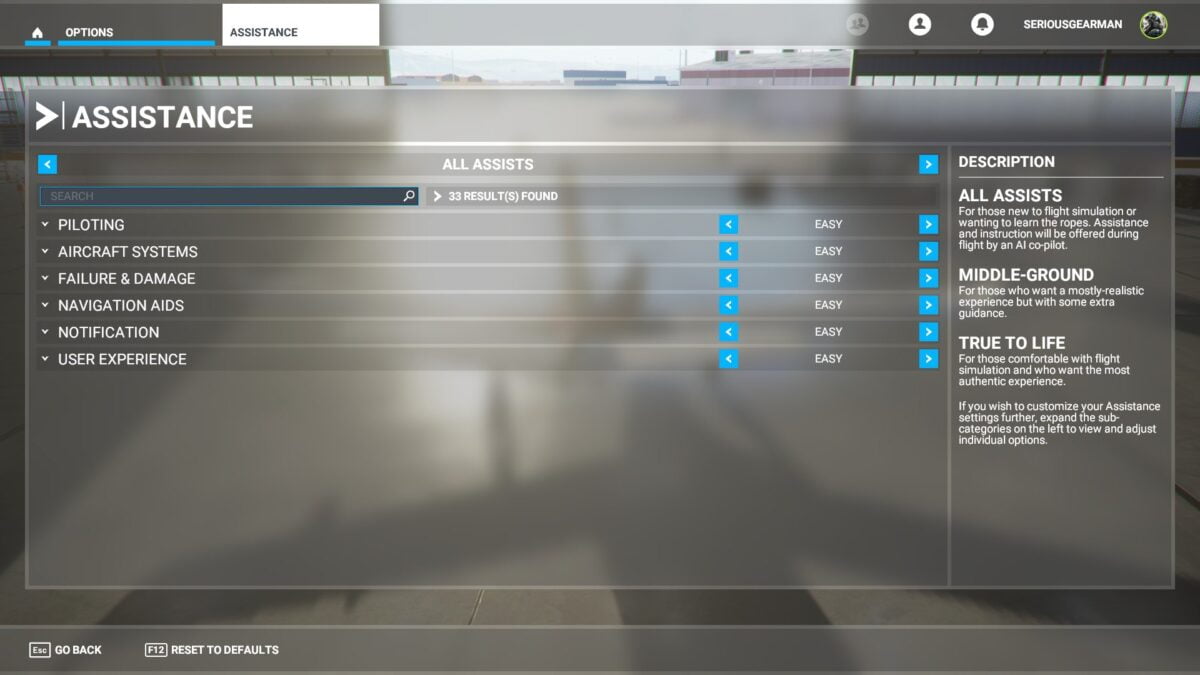
- Professional tip: You can adjust the difficulty level and other basic settings at any time – even during flight – by pressing the ESC key and then clicking on the “Support” menu.
In addition, the flight model setting in the “General” menu is also important, since here you can choose between a classical (Legacy) and a modern, i.e. complex flight physical model. This also influences the control capability and flight behaviour of the respective airplane.

- Professional tip: The unrealistic LEGACY model can only be setup with obsolete FSX flight models, which you should not use in FS2020!
The “Modern” flight model is based on a complex flight-physical calculation model which simultaneously calculates the resulting complex air forces at up to 1,000 different points on the airplane model (upper and lower surface of the wings, wing nose radius or leading edge, fuselage, landing gear, tail assemblies, flaps, etc.) and then determines the effect. From a physical point of view, the determined air forces (Force, downforce, drag) are the cause for a change of motion (path, speed, acceleration) of the airplane.
The airflow adjacent or upstream of your airplane is also taken into account for the calculation. For example, swirling airflow over hilltops or in stormy weather conditions influences the calculation and can lead to severe to uncontrollable turbulences. Local up and down winds can also cause “sagging”, a type of trickle-down effect.
Correct Selection, Operation and Adjustment of the Control Hardware
The first choice is quite simple: a joystick / HOTAS or a real Yoke! Keyboard, mouse or controller definitely do not fit the bill here, unless you just want to cruise around the world with the Cessna. For all other Sim fans, the choice of control hardware is determined by their favorite plane. Since there are no helicopters, gliders and military jets in FS2020, all Airbus pilots have to fly with the single-handed joystick (also known as sidestick or control stick). For all other airplanes we recommend the two-handed yoke (Y-shape). The reasoning is, that these input devices come closest to the mentioned control systems of the corresponding airplane types, and thus contribute to the realism of the simulation.
Even though the operation of the two control modes joystick and yoke is basically the same (e.g. “pull” means that the aircraft nose goes up, “push” makes the aircraft nose go down, etc.), the joystick has another big advantage: The function of the rudder is already integrated (rotation around the joystick vertical axis), whereas additional rudder hardware (foot pedals) is mandatory when choosing the yoke. However, those who appreciate total realism will also not want to miss the use of extra rudder hardware for the Airbus.
The correct adjustment of the joystick or yoke is a problem with Flight Simulator 2020 because it ought to be done individually for each airplane type. But FS2020 cannot save specific settings for specific airplanes. This is true for all airplanes equally, which means that you might have to adjust the settings in a laborious way every time you change your aiplane. Universal settings such as visual displays on joystick buttons or gear up/down are not affected by this, but the sensitivity settings for the control behavior have to be adjusted for each airplane separately. It would be desirable for the developer to add an option to adjust these settings separately for each airplane type.
Of course, this problem won’t bother you, if you only fly your favorite airplane all the time.
Which Airplane should I fly first?
- Obviously, there can only be one answer: The Cessna!
The Cessna is probably the only airplane that comes with a detailed and, above all, realistic flight physics implementation (just as it is the case in the competing X-Plane game). In addition, the Cessna is a High-decker/shoulder winger, which means that the wing is located on the fuselage, which results in a high degree of inherent stability. Furthermore, the high-lift devices or flaps of the unbowed wings (no angle of attack opposite the fuselage), which have a pronounced standard lift-bearing profile, are of less importance in the subsonic flow range (subsonic, much lower than half the speed of sound Mach 0.5, i.e. approx. 600km/h) than, for example, those of airliner jets. Those have supercritical and swept wing planforms, which can – if at all – hardly be take-pff and land without high-lift devices. This does not mean that airliner jets are instable, but they are not suitable for entry. Attention: This also includes small business jets such as the Learjet or Dassault Falcon.
In the single-engine Cessna, only the gyroscopic effect (i.e. the lateral force caused by accelerated rotating parts of the engine) can cause some difficulties during the start-up phase. Apart from that, the Cessna is a relatively simple and good-natured airplane, which is perfectly suited for fast reconnaissance flights (according to VFR rules for Just-For-Fun flights), since the safe airspeed is in a low range of about 80 knots (approx. 160km/h).
Which Cessna you should choose, is really a question of taste. The editorial staff recommends the Cessna 172 Skyhawk as a starter model, since it is already equipped with a modern autopilot-capable Garmin navigation device – and in addition to that, there are still the conventional navigation devices. The distinctive autopilot capabilities also make it easier to switch to more complex TurboProps, or even jets at a later date.
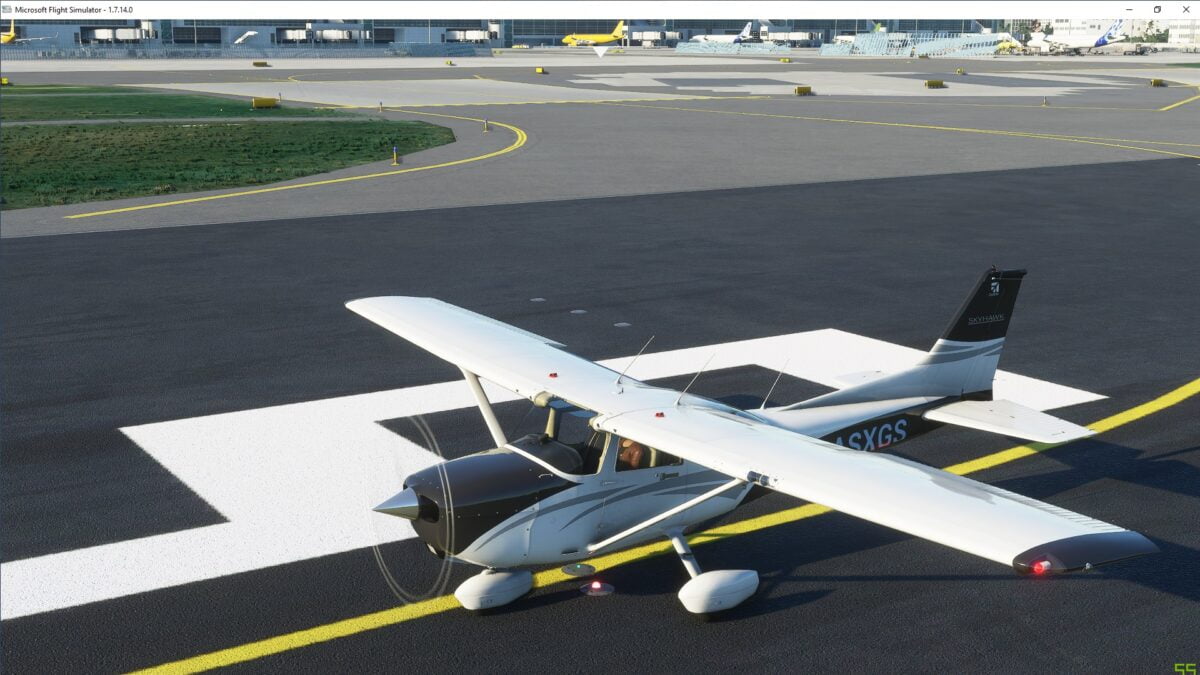
Overview of the most important Cockpit Instruments
We will start by introducing the most important cockpit instruments. All other cockpit instruments and functions will be introduced in detail at a later point in this article.
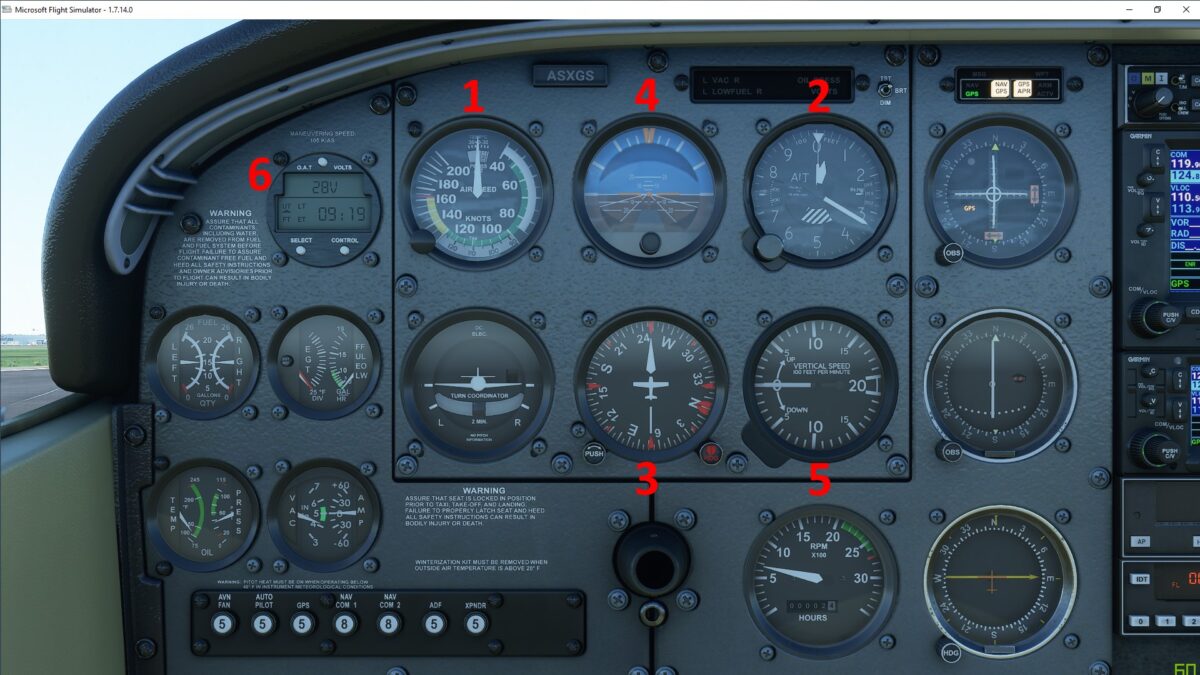
The most important Cockpit Instruments & Tips
- Airspeed Indicator (1)
The airspeed indicator is the most important instrument in an fixed-wing airplane (airplane with wings). It measures the air speed of the air flow attacking the wings in the form of dynamic pressure (IAS, Indicated Air Speed). And this dynamic pressure matters the most during flight.
Attention: In no case should the airspeed indicator be compared to the speed display in a car. Since the car is driven on the ground, it only measures the ground speed (GS, Ground Speed). The indicated airspeed IAS depends on the standard pressure, temperature and density of the air and it corresponds to a standardized standard atmosphere (ISA, International Standard Atmosphere) – which is why it is only suitable for light aircraft at low altitude and low speed. The cockpit panel label 105 KIAS above the clock (6) of the Cessna highlights this connection.
Because air is compressible, errors may occur in a KIAS display at higher speeds – that is, if you still use the so-called True Air Speed (TAS). Therefore, this speed indication (corrected in respect to the dynamic pressure KIAS) is used for airplanes with a higher speed range than the Cessna. In aviation, speeds are also measured in knots – with a few exceptions, such as with gliders. A knot defines one nautical mile per hour and is equivalent to 1.8 kilometers per hour (km/h) in the metric system. The letter “K” is used as a prefix for the above-mentioned speed indications.
In short: in aviation you have to deal with the speed indications KIAS, KTAS and GS. The Flight Simulator 2020 menus use KTAS as the default speed indication. This instrument cannot be replaced by human senses. - Altimeter (2)
The altimeter displays the altitude above sea level and is determined by barometric air pressure. Unlike the dynamic pressure of the speed indicator, this is a static pressure. Attention: The displayed altitude represents the height above Normalnull (“Standard-Zero” in German), and is therefore corresponding to Sea Level, and is also standardized in accordance with the ISA. The latter in turn is set at the value 1013mbar or hPa as the standard barometric pressure (Standard Baro Reference). Any changes of this standard pressure must be readjusted in the altimeter display by the pilot, or else the altitude indication of the instrument will not reflect the actual altitude. Alternatively, you can try to estimate the altitude based on your experience by looking down to the ground – but especially at higher altitudes, this is not exactly accurate. Thus the altimeter is the second most important instrument in an airplane. If you look at the cockpit of very old airplanes, you will notice that most of them have only very few instruments. However, you will speed indicator and altimeter will always be there. - Compass (3)
The compass is the navigational device that tells you the current flight direction relative to the geographic north. 0° means you are heading for the north. Continuing clockwise, the eastern course is 90°, the southern course 180° and the western course 270°. So, flying once in a circle from the initial course (e.g. 30°) to the next course equals a full circle of 360°. Semicircles of 180° are important flight curves that need to be performed in the so-called holding loops, which have to be flown twice (including two straight sections) when you want to return to the starting point in every holding loop.
Attention: Similar to the speed indicator, the compass course only represents the compass direction of the airplane nose. The true flight direction is only obtained by vectorially superimposing the compass direction and crosswind direction and – to make things even more complicated – by correctly taking into account the two speed components “flight” and “crosswind speed”. The correlation becomes clear when there is no crosswind: only then does the compass course direction match the actual flight course direction.
Alternatively, it is also possible to navigate by time of day and position of the sun, or on the basis of significant landmarks such as rivers, mountains or structures like churches and highways. However, this only applies under visual flight conditions and rules (VFR, Visual Flight Regular). This could be difficult at night though… - Attitude Indicator (4)
The attitude indicator displays the current position towards the ground in relation to the horizontal lateral position (lateral inclination/falling of the wing to the left or right to the ground) and the vertical inclination (nose of the plane up and nose of the plane down). If visibility conditions are good, the visual sense can be used as an alternative by looking forward and to the side. A pilot cannot rely on the visual sense in fog or darkness though. The attitude indicator is irreplaceable under instrument flight rules (IFR) - rate-of-climb indicator/Variometer (5)
The Climb Meter displays the climb / descent rate of the aircraft in feet per minute. One foot (ft) equals one third of a meter, or 0.3 meters. 1,000 ft/min. therefore equals about 300 meters/min. or five meters per second, which is equivalent to about 18 km/h. By the way: Such a sink rate or touchdown speed would result a very hard landing! Better are touchdown speeds below 500 ft/min., which is about 9 km/h. Alternatively, you can use a variometer and the clock (6) to precisely calculate the temporal changes of the altimeter display. A measured time of five seconds for an altitude change of 100 ft would correspond to an approximate ascent or descent rate of about 1,200 ft/min, i.e. approx. 24 km/h. - Clock (6)
The clock is the most underestimated instrument on an airplane. The clock is actually a chronograph. It shows, among other things, the time of flight so far as well as the time left until arrival at the destination. In addition, the clock also serves as a stopwatch that can be used to determine alternative sink/climb rates and/or even turn rates. Furthermore, the amount of fuel needed to reach a certain destination can be measured by looking at the current fuel consumption. The clock also displays the world time (UTC), i.e. the time at prime meridian (world longitude zero from North Pole to South Pole through the English town of Greenwich) and thus conforms to a standardized reference time on a global scale. This time is very important for flights across national borders and continents, but regardless of this, is used in every flight plan anyway. - Radio/NAV
Communication with the outside world is kept up via radio during flight. To allow clear communication, the VHF frequency range of the radio typically lies in the VHF MHz range . But the radio also provides navigation (NAV) functions in addition to communication (COM). Special transmitter frequencies (VOR, NDB) can be set here, which are then evaluated by navigation display instruments. The current course direction to this transmitter, for example, is displayed on them. If the radio fails, it is also possible to communicate with the environment by swivelling the aircraft and giving hand signals from the cockpit. Whether that is really effective, is another question though.
- Professional tip 1: For a better idea of the current airspeed (KIAS), simply double the knot value to get to the usual km/h value. The measurement inaccuracy of around ten percent is already acceptable because the true speed over ground (GS) is not shown anyway. The same applies to the Nautical Miles (NM), which give you – together with a factor of 2 – a more accurate estimate of the distance in kilometers. Experience shows that you will most likely not develop a sense for a nautical mile – even after years of flying in a simulator. So just get used to this conversion immediately.
- Profit tip 2: Based on the above explanations of the flight instruments, it is clear that when flying, every evaluation of the current instrument display must always be made in regards to air pressure, temperature, wind speed and direction. The following examples demonstrate the correct behaviour in flight:
– “My currently indicated northern course is good in regard to the runway ahead of me, but the current crosswind is coming from the east. When I set down in a minute, I will arrive on the left side of runway, if I don’t correct the course.”
– “My currently displayed altitude in the altimeter is good in relation to the mountain top in front of me with a known altitude, but the reference air pressure value of the altimeter set at start is higher than the local, actual static air pressure. When I reach the mountain in one minute, and I don’t correct my course, I run the risk of crashing into the mountain“.
Step by Step Guide: How to Take Off quick and easy
- With this step-by-step guide for Flight Simulator 2020 you can take off with your plane with ease and experience Frankfurt am Main from above.
You can already get into the air immediately and safely after a brand new and not yet customized installation of the FS2020 – even without joystick or thrust lever. This is completely safe and requires no understanding of flying or flight physics.
- Tip: Be sure to play through the tutorial at the beginning!
Just follow these steps:
- The following steps are absolutely realistic for a real flight in calm conditions. This flight experience would also be possible in a real airplane, since a fixed-wing airplane is an inherently stable aircraft. Under no circumstances would you crash or observe a deviating flight course.
- Click on “World Map” in the main menu.
- Click on the airplane selection and choose the Textron Cessna 172 Skyhawk. Then click on “Close” in the lower left corner.
- Click on “Flight Conditions” and
– switch off Multiplayer and Air Traffic, and select the “Standard” setting for Weather & Time,
– select the weather preset “Clear Skies” on the righthand side,
– set the time to 12:00,
click on “Close” to return to the world map menu
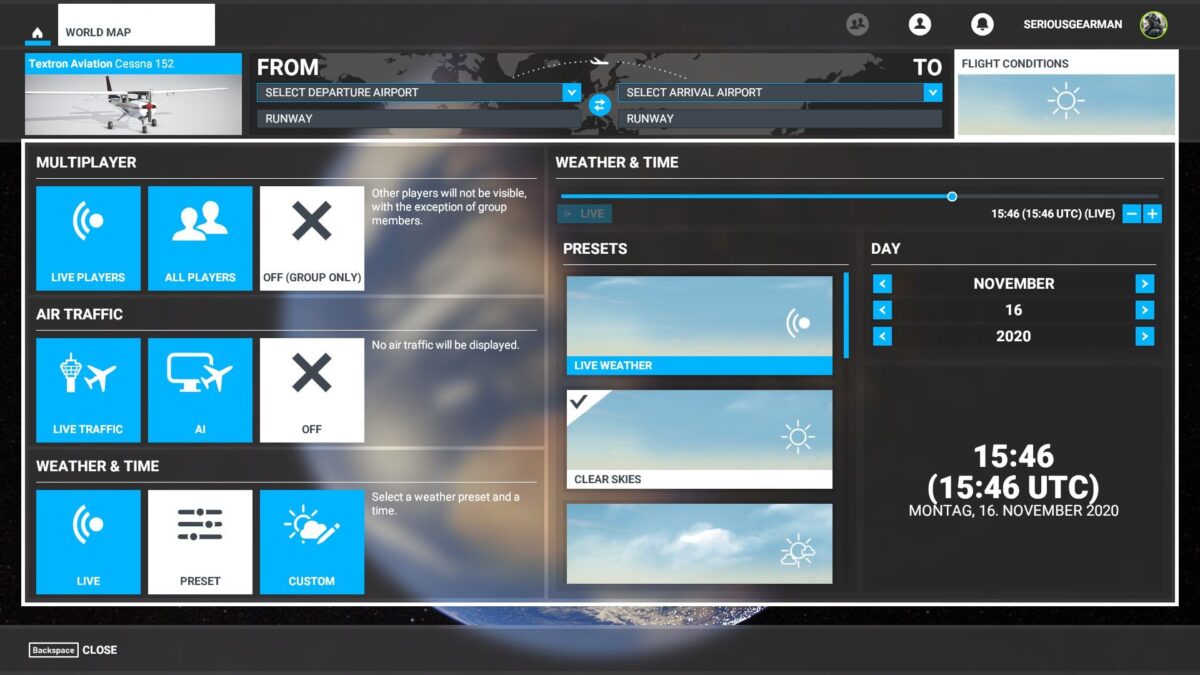
- Click on the upper input field under “From” and type EDDF on the keyboard.
- Select EDDF Frankfurt/Main, Frankfurt/Main in the drop-down window.
- Select the white runway starting point for Runway 25C (RWY 25C) to highlight it in green.
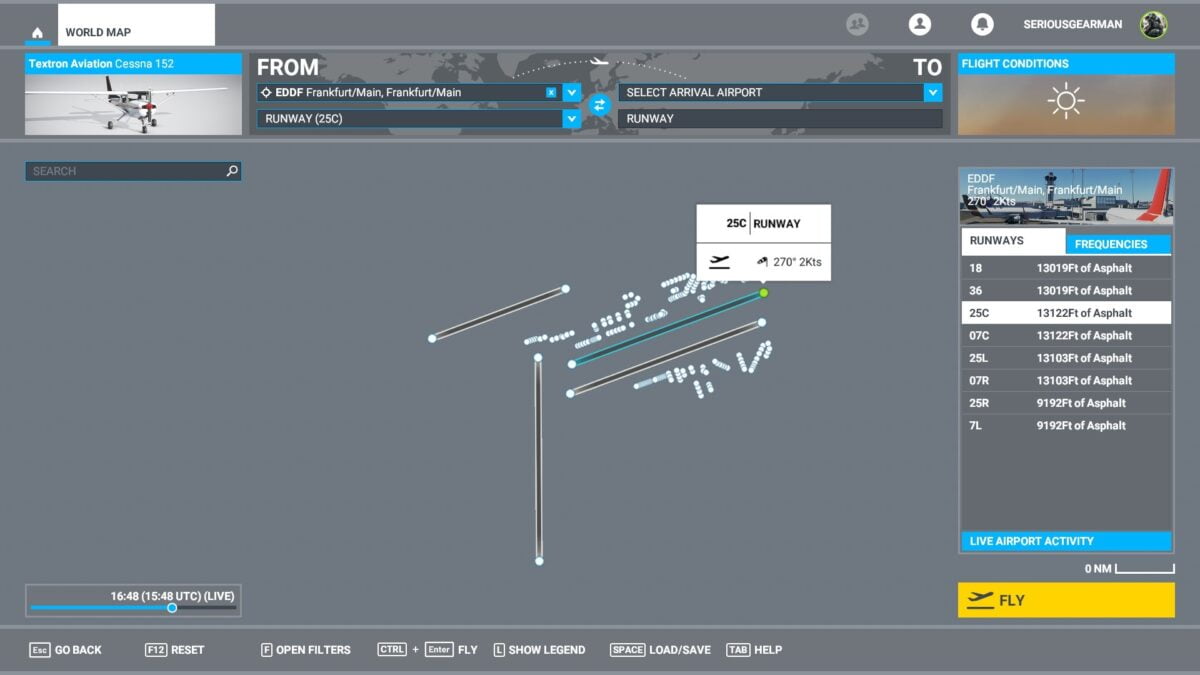
- Click on “Fly” and wait till the loading process is finished.
- Skip the upcoming cutscene by clicking on “Ready to fly”.
Now you are in the cockpit of the Cessna, which is located on runway 25C with a view towards the western direction (270°).
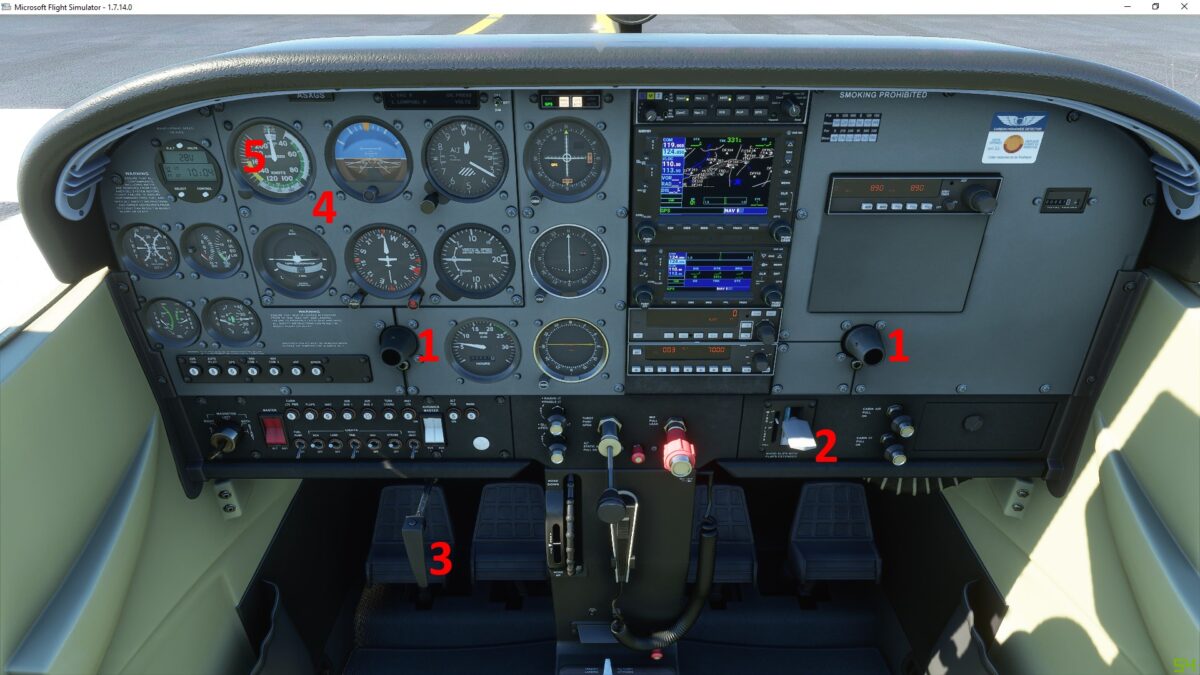
- General note: The cockpit view can be changed at any time by holding down the right mouse button while simultaneously moving the mouse (mouse view). In addition, the instrument panel can be zoomed in or out via the mouse wheel.
- Hide the yokes (1) by simply clicking on them.
- Check the position of the flaps (landing flaps or High-lift device) by mouse-over over the flap lever (2). The value should be approximately 30 percent. If it is not, move the lever until a value of roughly 30 percent is displayed via quick info.
- Release the parking brake (3) by clicking on it once.
- Adjust the pilot’s view with the [Up / Arrow up] key or with the mouse, until you have a good view of the runway, but are still able to see the cockpit instruments (4).
- Keep the plane on the centerline by pressing [NumPad 0] (left) and [NumPad ENTER] (right).
Important: Be sure to press the respective key only once for each control command! - Press and hold the [F3] key for three seconds to apply full throttle (thrust). If the propeller plane pulls to the side when rolling off due to the gyroscopic effect, correct this by pressing the above mentioned keys once.
- You may need to correct the airplane’s alignment more often in the beginning, but with higher speeds you will need to do it seldom, since the vertical stabilizer will more effectively keep the plane straight on course due to the increasing aerodynamic effect.
- Read the speed indicator (5). At 70 knots, i.e. almost 130 km/h, the plane starts to take off by itself and at 80 knots you will already be in the air. Congratulations – you are flying!
- Relax and enjoy the climb phase of the flight, and take a look at Frankfurt Airport via mouse view. In the meantime, you can adjust the flap lever (2) all the way up to zero percent. After a brief moment, you will see the West runway passing you on the left.
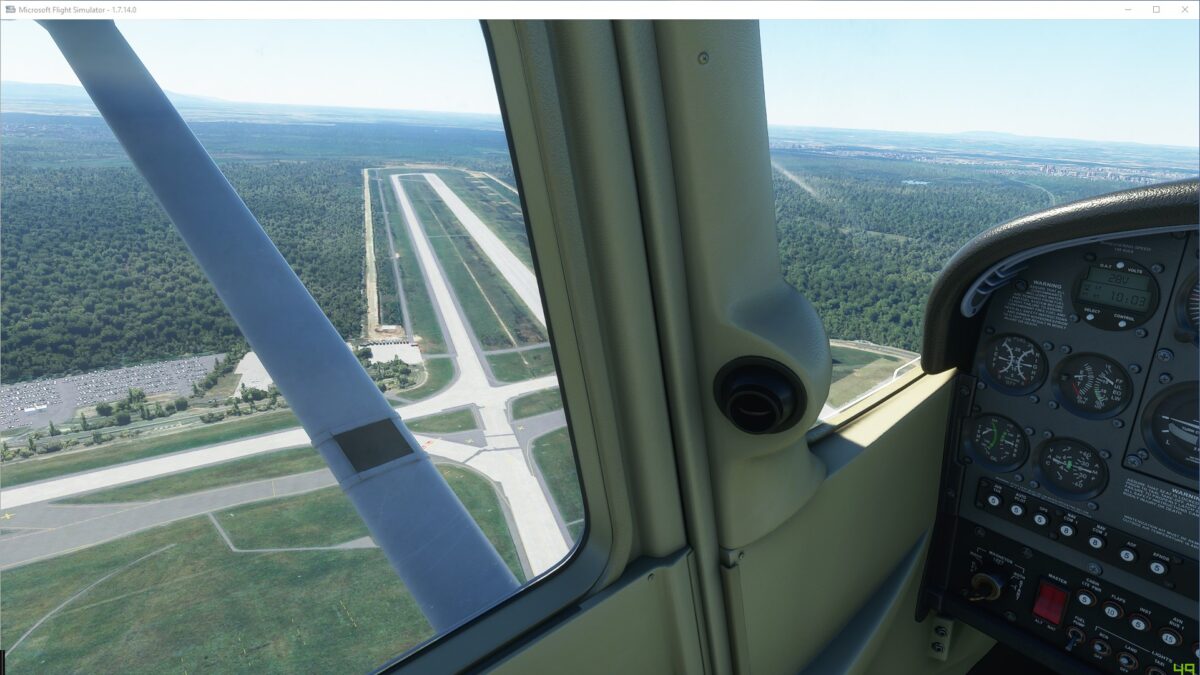
- Let’s try the Turning Flight
Looking forward, press [NumPad 6] once. The plane will slowly turn right. At a noticeable, but still slight inclination, press [NumPad 4] once. The airplane will now remain in this inclined right-hand position. Wait until the skyline of Frankfurt is visible in front of you. You will surely want to take a closer look at it.
Press [NumPad 4] briefly until the inclination to the right is completed and press [NumPad 6] again as soon as you are back in horizontal flight. The turn is finished. Correct any inclination changes by short counter commands using the known keys, and then fly over Frankfurt City.
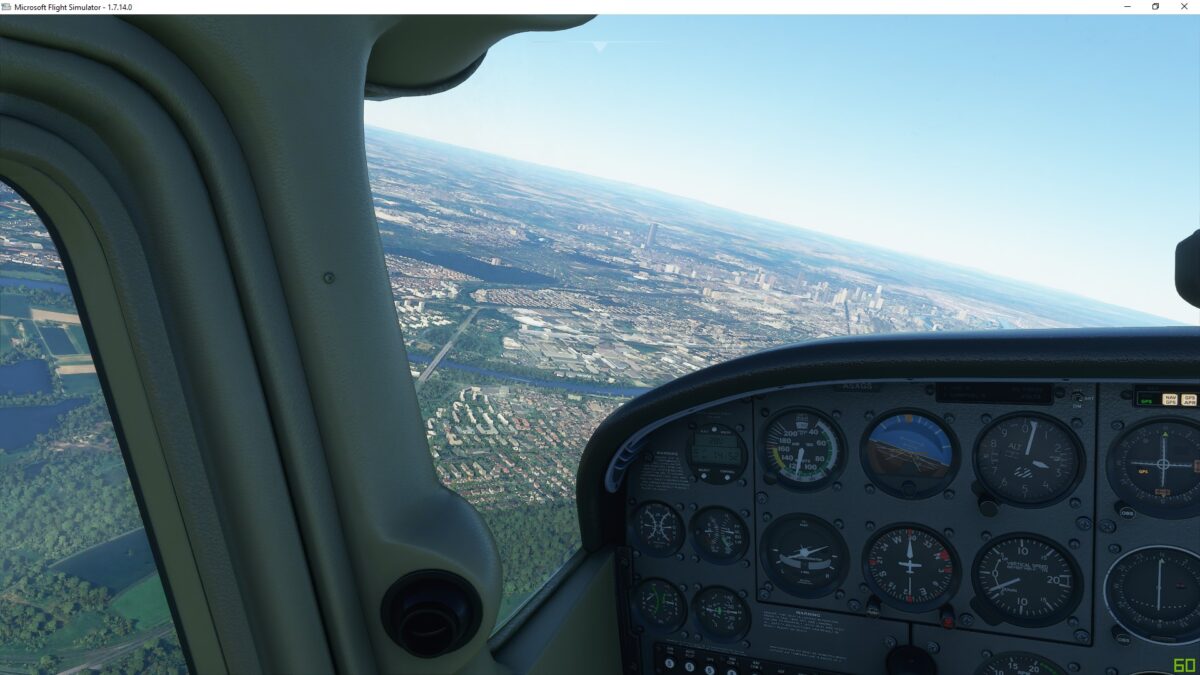
- Should the airplane rise and fall several times during a short flight, no correction or countermeasure inputs are required. The airplane always balances itself, meaning that it always tries to fly in a horizontal position.
- Read about Landing in Flight Simulator 2020, which comes at a later point in this article. Perhaps instead of trying to land, you might want to practice turning for a while (until the situation gets out of control or your fuel runs out). In that case, press the [ESC] key and return to the main menu. I hope you had a pleasant flight so far.
- It goes without saying that an airplane can only be flown sensitively and in a controlled manner by using a control horn or stick (yoke, sidestick/joystick), and that a landing approach without this control hardware is basically a hopeless endeavor.
Flight Simulator 2020 Flight Missions: Tips and Tricks
In this section
- General Tips for conducting Flight Missions in FS2020
- Which Destinations should I fly to first?
- Saving different Flight Situations & Loading them for Training Purposes
- Briefing: Compiling all Flight Data
- Ensuring Situational Awareness (Loss of Orientation)
- Landing in Flight Simulator 2020 – The Greatest Challenge of Flying
- Debriefing: Reviewing the Flight
This section is very practice-oriented and requires hardly any knowledge from the previous sections. Here it depends specifically on the issues that need to be considered besides the actual flying or rather how the playing experience can be actively influenced during the game.
General Tips for conducting Flight Missions in FS2020
- You can interrupt the game at any time by pressing the [ESC] key. This will return you to the options menu of Flight Simulator 2020. This is especially useful, if you want to change basic settings, that have a direct effect on the further course of the game.
- Alternatively, you can activate the pause mode, which can be assigned to a key like [P] in the keyboard settings. A clickable pause button can also be found on the far left of the simulation window menu (upper middle area). This mode comes in handy, if you want to change the camera perspective and, for example, take a look at a place of interest and its surroundings.
- Tip for Non-English speakers: You will have to get used to English terms in aviation. Pronunciation is not so important here, unless you want to communicate via microphone with ATC (Air Traffic Control) within virtual airlines.
Which Destinations should I fly to first?
For beginners in particular, it is helpful if the destination airport and surroundings as well as large parts of the planned flight path are already familiar. For this reason, practice the same route several times at the beginning. Navigation is getting easier, and then you can focus more on the essentials, such as flight control.
This also benefits you, as you can already orientate yourself better during the preparation for the approach (Arrival) and the final approach to the runway!
Example: In front of me is the stadium XYZ and according to my approach map, I have to pass it on the right side until I reach the river XYZ. This gives me about five minutes left, so I reduce my speed, report to the tower and set the landing flaps to position 1.
Or to put it more simply: Since we have just flown over the Alps on our flight path, we have to start descending immediately. I keep the checklist for the descent at hand.
Saving different Flight Situations & Loading them for Training Purposes
In case the current flight has to be interrupted for a prolonged period of time, the current flight situation can be saved in Flight Simulator 2020 and be reloaded later. This function is also useful for practicing difficult landings without having to repeat the whole flight and its preparations.
Switch to the options menu via [ESC] during the flight and save the current flight situation via “Load/Save”. Note that you save the flight without special characters and umlauts (“sound alteration” for the Non-German speakers). Use underscores instead of spaces.
Briefing: Compiling all Flight Data
The so-called briefing (preparatory meeting) prepares you for an upcoming flight. Central topics include the weather, flight path planning, travel altitude, estimated flight time, number of passengers and the cargo that needs to be transported.
The current weather situation is particularly important. While a flight under visual flight rules (VFR) requires certain minimum visibility conditions, e.g. minimum visibility for the flight path, this is generally not required under instrument rules (IFR). However, under both rules, weather conditions must always be taken into account when planning a flight. For example, strong headwinds have an influence on fuel consumption and thus on maximum take-off weight, maximum flight distance and consequently on the estimated flight time.
A detailed planning of the flight path with regard to the intended flight route is also important. Particularly detailed flight routes show every single waypoint that is to be passed. The most important waypoints are, of course, the point of departure and arrival, i.e. the airports that must always be specified. Both (arrival and departure) can be the same for a round trip or an aerodrome circuit.
The information material to be carried along on this flight is derived from the flight path planning. This includes flight charts describing the departure and arrival airports as well as all relevant IFR and VFR charts for the flight path. In addition to this, associated navigation and radio frequencies are determined and noted, such as the COM tower frequencies and the VOR, NDB and ILS transmitter frequencies for the flight plan. The evaluation of the individual ATC frequencies in the flight path environment can also be useful for VFR flights – after all, you might get lost.
A proper briefing also includes other things, but these are automatically added during the flight simulation experience. For a detailed and in-depth discussion of this and other topics related to the actual flight, please refer to our upcoming guide “Flying Properly with Flight Simulator 2020”.
Ensuring Situational Awareness (Loss of Orientation)
A good pilot always knows where he is in the present moment, where he will be in five minutes and, above all, what flight situation he will encounter then. The overall flight situation consists of the current concrete awareness of the location and flight parameters such as speed and altitude. Only those who have a clear situational awareness of the current flight situation can anticipate upcoming situations. Behind this stands a crucial principle, since a loss of situational awareness leads to dangerous situations – especially during critical flight phases. While the pilot may emerge relatively quickly and safely from this situation in a cruise flight, this is hardly possible during the approach phase – especially when visibility is restricted by darkness or fog. Numerous investigations into air accidents confirm the unconscious loss of orientation.
Example: A pilot assumes that he is at this or that point in the air and therefore initiates the descent for landing five minutes later. The descent is executed accordingly to the approach chart, i.e. with a predefined descent rate and course. However, due to the wrong outset, it collides with the mountain to the right of the runway.
Even though we are not putting ourselves into an actually life-threatening situation by playing Flight Simulator 2020, this experience is nevertheless unpleasant, because in the real world we and all passengers would be dead now. You must be aware of your whereabouts at all times!
Our upcoming guide “Flying Correctly with Flight Simulator 2020” will provide you with detailed information on how to deal with this, what to do and how to behave correctly, to ensure that you never lose your orientation unconsciously.
Landing in Flight Simulator 2020 – The Greatest Challenge of Flying
Both in the real world and in Flight Simulator 2020, landing an airplane safely at its destination airport is hard to top in terms of difficulty. You have to handle the navigation instruments correctly, amongst other things.
However, this would go beyond the scope of this guide, hence we have to ask you to wait for our upcoming guide “Flying Properly with Flight Simulator 2020”. There we will cover flight parameters, control aids, ground effects, turbulence, crosswinds and other physical phenomena as well as the background and theoretical principles and provide you with a step-by-step guide for the perfect landing.
Theory: Debriefing – Reviewing the Flight
The so-called debriefing is a standard procedure in aviation, which allows you to review the events of the entire mission after a completed flight. The debriefing process compares general things like actual fuel consumption versus the originally planned fuel consumption or originally planned and actually required flight time. But also more trivial things (such as wether all passengers had enough to eat) are considered. If there are major discrepancies between planned and actual data, an investigation to find out the reasons for these deviations is conducted, and suggestions on how these things can be improved on the next flights are developed.
Much more important in this context are possibly occuring exceptions, i.e. unexpected or even safety-relevant events. These must be documented more extensively and sometimes reported to the responsible aviation authorities. An extreme example would be a near-collision with another aircraft or if a passenger had to be medically treated in the cabin.
Unfortunately, Flight Simulator 2020 does not have a flight repetition function which makes it possible to review the entire flight afterwards. This would be particularly helpful for beginners, as it would allow for a deeper analysis of situations such as the landing, when reviewing it in the debriefing session. The repetition of the flight at certain points in time, and from all possible perspectives (e.g. looking at an instrument in the cockpit or looking at the aircraft from the outside during landing approach) would be a useful tool, and it is even provided by most of the other known simulators. Viewing the flight again via video recording software is of limited benefit due to the lack of interaction possibilities. For example, it is not possible to pan the camera or to zoom in on an instrument. But since one would want to view critical flight phases from all angles, this is not a good alternative.
Perhaps Microsoft will add such a feature or a comparable one at some point. There is no flight repetition function in the real world though, and therefore this can’t really be considered a flaw of the FS2020. After all, real pilots and crew members work from memory or on the basis of notes.
Flight Simulator 2020 Cockpit: Instruments & Airplane Functions in Detail
We have already introduced the most important cockpit instruments (1) for beginners in the section Overview of the most important cockpit instruments. In this chapter we will introduce all remaining cockpit instruments and also the control aids and operating elements that have not yet been mentioned. This chapter is therefore relevant for experienced flightsim fans as well, and it does not only cover the underlying Cessna Skyhawk.

Navigation and Communication Instruments
Several instruments such as the autopilot (16), navigational instruments such as the ADF/VOR or ILS displays (4, 3, 2) assist us directly during more advanced flight maneuvers like landing. We receive indirect support by air traffic control (ATC) through communication instruments such as the radios COM1 and COM2 (14, 15), during mission sections such as take-off, cruise flight and landing. During flight, our aircraft sends out a signal via transponder (17), which enables the ATC to identify our airplane. The transponder code is provided by the ATC and consists of four digits (for example 3421). The code has to be entered into the transponder before every flight.
Modern navigation systems can be used in conjunction with the autopilot, classic navigational equipment as well as GPS devices (e.g. Garmin 1000) to fly even complex pre-programmed RNAV flight paths in a fully automated manner. Switch on the autopilot after take-off, including an automatic landing (CAT`III procedure, only supported by airliners such as the A320 or B737), and you wont have to worry about anything else, other than checking displays and communicating with the ATC.
State-of-the-art airplanes are equipped with additional instruments such as the TCAS (Traffic Alert and Collision Avoidance System), which – in conjunction with GPS, inertial navigation systems and transponders – alert the pilot to dangers and recommend evasive action in dangerous situations, such as an impending collision with an aircraft. Other dangers, such as an impending collision with an obstacle like a mountain (terrain warning), are detected by powerful GPS and/or by an additionally installed radar system.
Electrical System
Nowadays, aviation would be impossible without electrical systems. All airplanes are equipped with at least one battery that supplies various electrical systems with power. The most important electrical system is the communication system, which is indispensable for radio communication. Even non-motorized aircraft such as gliders have a battery that discharges while in use. Piston- or jet-powered airplanes, on the other hand, recharge the battery(s) permanently via the electrical generator that is linked to the engine.
For autonomous operation, large airplanes – mostly airliners – are also equipped with auxiliary gas engines (APU, Auxillary Power Unit) and special emergency systems such as the ram air turbine (RAT), which – in the event of an engine failure – draws energy from the kinetic energy of the air. Basically, this is a wind turbine that is held in the airstream. The electricity generated in this way is then used for the most important cockpit and flight control systems (actuators).
All airplanes are equipped with at least one MASTER BAT main battery switch (22, right), which activates the on-board power supply. This is usually the first switch that is pressed in the cockpit. Since the start-up of the cockpit and aircraft systems – especially on large airplanes – requires a lot of electrical energy, it is also possible to add an external power supply during the first phase (EXT PWR, external power). The generator takes over the power supply once the engine has started. Push the ALT (22, left) switch upwards. However, generally the switch should always be in this position by default.
The differences in switch positions on the Cessna can easily be read off the ammeter display AMP (6). The AMP displays the amperage / current flow going into and coming out of the battery. The AMP display shows exactly 0 A (amperes) before the aircraft systems are activated via BAT – i.e. from the so-called Cold & Dark State. After turning on the BAT switch, the AMP display shows positive (+) current flow, i.e. voltage flowing from the battery towards the aircraft systems, such as the radio. This means that battery power is being used. After starting the engine, the current flow drops into the negative (-) range, usually slightly below 0 A. Accordingly, no more current is drawn from the battery, but instead the battery is charged.
This becomes obvious when the ALT switch is pushed down and the generator power is switched off. The AMP display then jumps sharply into the positive range, since the battery alone must now provide all the electrical energy for the on-board systems and engine electrical systems.
Control and Flight Assistance Systems
The following control and flight assistance systems support pilots in taking off or landing an airplane safely and comfortably as well as in stabilizing the altitude and direction of the airplane during the flight. They must not be confused with the basic control instruments such as the elevator and the rudder, as these are required for maneuvering.
During take-off and landing, lift aids such as flaps (8) (flaps and slats) help to compensate for the fundamentally missing lift effect of the airplane construction in these flight phases.
Furthermore, there are so-called trim tabs (13), which can fine-adjust the flight position via the transverse axis (pitch position, i.e. nose up/down) and the vertical axis (yaw position, i.e. nose left/right). The terms pitch and yaw are used in the English language, meaning that we are dealing with pitch trim and yaw trim control aids. You can see them on the cockpit labels as well. The trim is achieved by devices on the control surfaces of the tail unit at the tail of the plane, i.e. aileron for the yaw and elevator for the pitch.
Last but not least, there are the airbrakes and ailerons. The former help to reduce excessive airspeeds and the latter help to enable a harmonious turn, i.e. putting the airplane diagonally into the curve.
In our upcoming guide “Flying Correctly with Flight Simulator 2020” we will explain the exact function of the control aids and with it the aerodynamics of an airplane as a whole, as well as the effects it has on a flight in Flight Simulator 2020. You will find answers to questions such as “why do the flaps increase the lift”, “when are they allowed to be used” and “what are the disadvantages of using them”?
Lights
Airplanes are equipped with various illumination devices that are important for certain mission sections. There are Nav Lights (NAV, Nav Lights), Landing Lights (LAND), Strobe Lights (STROBE), Beacon Lights (BCN), Taxi Lights (TAXI), Wing Lights and Runway Turn Off Lights. There are also other and in some cases exotic lights such as Logo Lights, which illuminate the company logo of the airline on the vertical tail. The last three mentioned lights are rarely seen in small airplanes like the Cessna Skyhawk.
The pilot operates the lights from the cockpit by pressing the respective switches (10).
Aircraft Engine
Aircraft engines (Engine) can be either piston engines, jet engines and electric motors. There are three variants that ensure the actual propulsion of the airplane. For example, there is the free propeller (also called airscrew), which rotates freely in the air – just like the one on the Cessna. Propellers mounted into cylindrical casings are primarily used in modern turbofan engines, in whose core a jet engine is acting as the motor. The resulting propulsion is formed by the turbine’s exhaust gas stream and the propellers (fan) located in the cowling- in other words, an air stream and an exhaust gas stream. The remaining combination type consists of a jet engine with a free propeller and is also known as a turboprop. It is a frequently encountered type of aircraft propulsion.
Besides tunnelling, the engines are also responsible for generating power, hydraulic pressure as well as air pressure (cabin air compressors). The engine power is therefore never used exclusively for the propulsion of the aircraft. For this reason, many airliners switch off the cabin air compressors (PACKS) in the take-off phase to provide maximum thrust (propulsion). This is particularly important on short runways.
Fuel
Gasoline (AVGAS, Avionic Gasoline) and kerosene (Jet A-1) are available as aviation fuels for the various types of propulsion. They are characterized by their exceptional purity and quality. These fuels cannot be compared with conventional fuels for cars (gasoline, diesel), as they are exposed to constantly changing and extreme flight conditions (temperatures) and must therefore be much safer.
The volume unit used for aviation fuels is the liter in the metric system and the galon in the English unit system (approx. 3.8 liters). In aviation, however, the measure of all things is weight, since you fuel “weight” and not “volume”, which means that you have to consider things in a different way than, for example, when you use a car! One liter of fuel weighs about 0.8 kg (for comparison: 1l water = 1kg). Filling the tank with 100 liters or 26.5 gallons basically means you fill the tank with 80 kg of fuel. This is the foundation for safe flight planning, since weight or mass is the base for important decisions in flight planning. These include the minimum take-off distance required, maximum range, safe take-off speed, maximum take-off and landing weight, and much more.
Aviation fuels are usually filled into the wing tanks. Therefore, you have to deal with two tanks (left and right), which can both be viewed and controlled independently from the cockpit instruments (8). In modern commercial airplanes, the fuel is distributed and emptied optimally into up to five tanks via a complex pump control system. However, sports airplanes like the Cessna regulate this manually via the switch positions (27) BOTH, LEFT and RIGHT. BOTH, i.e. “both tanks” is always the best choice for the Cessna.
But be warned: Due to the hydrostatic effects which are combined with certain flight characteristics (e.g. left-handed circuits) and paired with the characteristics of the tank system (venting, return flow etc.), different consumptions can occur with both tanks. If the difference between the left and right tank is too great, the airplane’s center of gravity shifts gradually to one side. This is not a big deal, but you should check the fuel gauge (8) from time to time and, if necessary, decide to manually remove the fuel from one of the two tanks to keep the balance.
Landing Gear
Generally, every airplane has a main gear and a nose gear. The main gear is always located in the area of the wings and thus relatively central to the fuselage, as this is also the center of gravity of the airplane. The main landing gear must carry almost the entire weight of the airplane, especially during hard landings, where the touchdown delay (negative acceleration) can be very high sometimes. During a very soft landing (hardly any touchdown delay) the landing gear still has to carry the aircraft’s dead weight on the ground, as no aerodynamic lift is active then. The nose gear carries only a small mass from the center of gravity towards the nose, to ensure that the airplane stands safely on the three landing gear legs. It also absorbs the rotational energy during landing when the nose turns towards and touches the ground via the main landing gear. It is easy to understand why the main landing gear has to be much larger than the nose gear. Carrying parts of the landing gear are made out of high-strength aerospace steel or titanium, to be able to withstand the enormous forces.
Landing gears can be fixed to the aircraft, as is the case with the Cessna, or be retractable, as in the case with the Airbus A320 or Boeing 737. Retractable landing gears are highly complicated mechanical component assemblies that are designed and manufactured with great effort. They are permanently maintained and inspected to guarantee safe operation. Without retractable landing gears, modern commercial aviation would hardly be possible for numerous aerodynamic and economic reasons.
To operate and control the retractable landing gear, the cockpit of large airliners is often equipped with a gear lever with the positions “gear up” (retracted) and “gear down” (extended). The lever is always operated in the direction of the intended landing gear position Up and Down.
Air Conditioning
Every airplane is equipped with a ventilation and air conditioning system. In the case of the Cessna, it is operated by simple pull/push levers for fresh air supply (19, top) and heat supply (19, bottom). Airliners have an additional compressor to supply the cabin with compressed and fresh air, which is absolutely necessary at high altitudes (up to 15km above sea level), as otherwise the people on board would have to wear oxygen masks. The pressure is maintained at any altitude at a pressure level which, according to the International Standard Atmosphere (ISA), prevails at an altitude of around 3,000 meters above sea level.
Only fully automated systems are used for the operation and control of compressed air cabins. In the cockpit, there are only main- and regulation switches to control the cabin temperature and the basic cabin pressure level.
- Did you know? Modern airplanes like the Boeing 787 or A350 can fly at much lower altitudes due to their CFRP fuselage (Carbon Fiber Reinforced Polymer), as the fuselage diameter expansion is not as high as that of conventional aluminum fuselages, and can therefore withstand more pressure. This is also the reason why the windows of these aircraft are so much larger. So, choose an A350 or Boeing 787 for your next flight!
Are there any Signs of a Weight Indicator? Nope!
The weight indicator is literally a non-existent and your search will be in vain! There are some weight indications in aviation, such as: MTOW (Maximum Take Off Weight), MLW (Maximum Landing Weight), MZFW (Maximum Zero Fuel Weight), or the “Empty Weight”.
Before each flight a detailed weight calculation must be conducted. This requires the dry weight of the airplane, the fuel weight, the passengers, the baggage and so on.
For the Cessna pilot this means: Doing calculations using paper, pencil and a pocket calculator. The same applies for the airliner pilot – except that he is supported by his airline (pre-flight planning) and his ramp agent.
- Weight management is a complex matter and difficult to understand for novice pilots. This is where you need to gather experience, and in the beginning you should just leave it at a rough estimate of the fuel and passenger weight!
- Attention: The current version of Flight Simulator 2020 does not recognize the metric weight unit kilogram (kg). The only weight measure currently available is the English pound (lb, 1 lb = 0.454kg), but this measure is not exactly the most practical one. Internationally, a mix of units such as feet (ft) for altitude, nautical miles (NM) for distance and knots for speed, and kilograms (kg) for mass has been established.
Gain Greater Value from the FS2020: The Ultimate Experience Enhancement
In diesem Abschnitt
- Flying an Airliner – Probably the Most Interesting and Comprehensive Flight Experience
- Flying Airplanes in VR – The Ultimate Experience
- Home Cockpit: The Exceptionally Exclusive Flight Simulation
- Integrating “real” radio communication into the simulated flight experience
- “Real” Pilot Job: Flying in a Virtual Airline
Flying an Airliner – Probably the Most Interesting and Comprehensive Flight Experience
What is so special or different about flying an airliner?
It makes simply more sense to learn how to fly the Cessna first, since you won’t have to worry about passengers, time pressure, costs, flight attendants, weather conditions, controlled flights under instrument rules, virtual flight path points, fully automated approach procedures, airport ground staff and supplies, and much more.
But only after switching to an airliner, will you truly face all the challenges of flying. For example, you can’t fly off until all passengers are on board and the cabin crew has reported “boarding completed” to the cockpit. Furthermore, there is virtually no such thing as bad weather in the airliner business – basically, you have to fly in every weather condition. It is common that you have to take appropriate measures such as de-icing before and during flights in bad weather. In case of heavy fog, for example, you will have to contact the tower and choose an alternative CATIII approach procedure.
These examples give you an impression of what you have to pay attention to when flying an airliner, and what has to be considered and managed in addition to regular flying. The fascination of flying an A320 or a similar model is clearly rooted in the complexity of the challenge. In our upcoming guide “Flying Correctly with Flight Simulator 2020” we will go into absolute detail. Nevertheless, we will still address a few aspects in this article.
Airliner: Complex Cockpits, Complex Technology
Even when choosing a real airliner, such as the modern European medium-haul airplane A320neo, you will be confronted with a myriad of additional instruments and equipment in the cockpit, which are rarely found to this extent in private and business airplanes.
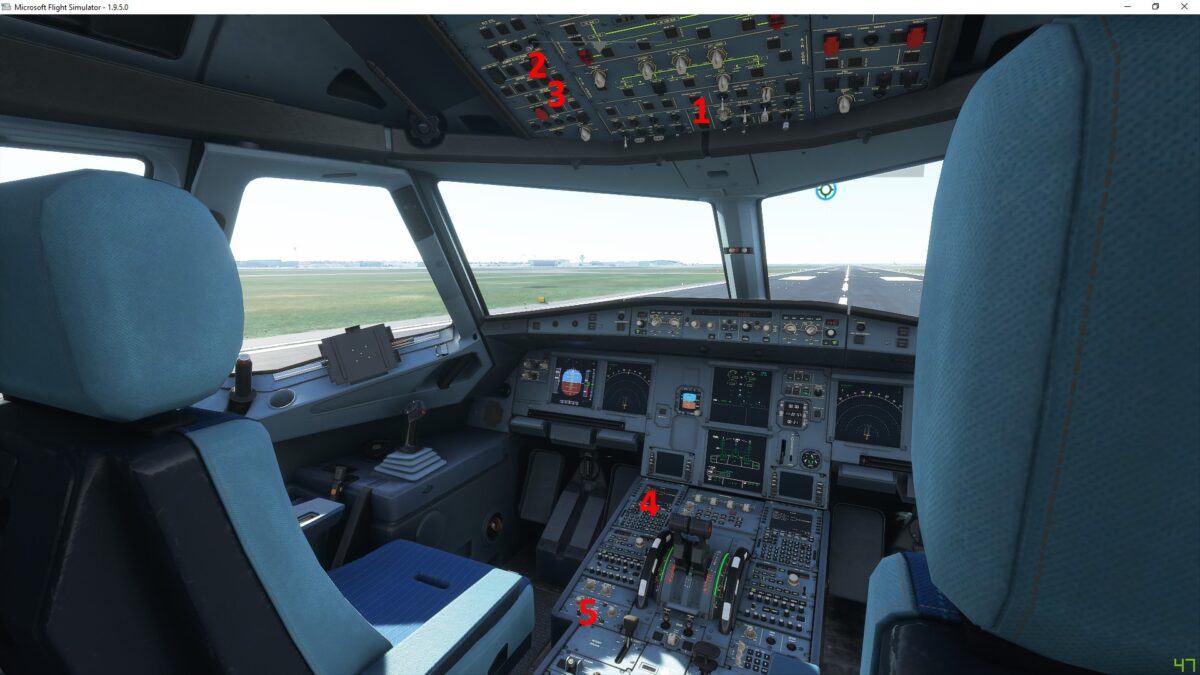
One reason for the more extensive cockpit equipment of an airliner are the auxiliary gas turbine (1), the emergency pressure turbine (2), the flight recorder (3), the flight programming unit (MCDU)(4) and the weather radar (5). We could also mention other additional systems like the de-icing system (Anti Ice) here. But it would be a far shortsighted approach, as if only the increased number of additional aircraft systems were enough to characterize an airliner.
Instead, fundamental aspects come into play, such as the significantly higher weight of an airliner as compared to the smaller private or business airplanes. In aviation, aircraft classes are defined by weight and are subjected to corresponding certification categories. For example, 5,700kg is a weight limit for which different certification criteria must be applied by the responsible certification authority (in Europe, for example, the EASA) for certification (TCDS, Type Certificate Data Sheet). An A320neo weighs around 75,000 kg when fully loaded, which is approximately the weight of 70 small cars. The weight of the aircraft has an impact on the minimum take-off distance required, which in itself greatly limits the choice of available airports and must therefore be taken into account when planning flights (keyword: Diversion airport). But physical restrictions must also be taken into account: For example, narrow curves cannot be flown due to the high inertia, which means that the extended curve flight must be taken into account when changing course.
Another important aspect and difference to conventional airplanes is the significantly different flight altitude of an airliner. It moves at altitudes of nine to 14 kilometers or FL300 to FL450 (FL, flight level from 30,000 ft to 45,000 ft) above ground, i.e. within the tropopause and at a relatively constant temperature. Thus, due to the extremely low air density of one-fifth of the air density on the ground (1.28kg/5=0.256kg per cubic meter or per 1,000 liters) in combination with the extremely low air temperature of around -55°C, you are flying at a much higher airspeed.
But that’s not all: Not only the KTAS (true air speed in knots) is relevant here, but also the speed of sound “Mach” (Ma). That means, you fly also according to the Mach number with your instruments! To be more precise, you are flying in a critical speed range, in which the leeway of the airplane becomes extremely narrow to vary the speed up (Mach) or down (KTAS)! If you fly too slowly at these altitudes, you will quickly experience a stall. If you fly too fast, you will quickly reach the local speed of sound on the wing, on which completely different physical effects will appear, for which the aircraft was not designed.
- Flying an airliner means flying in the critical transonic range! The speed of sound on the ground (1.250km/h) is much higher than the speed of sound at 10 km altitude (1.050km/h). This predominantly temperature-dependent quantity becomes more and more critical with increasing flight altitude (and thus decreasing air temperature), since it becomes smaller at the same flight speed, i.e. the speed of sound comes closer to the flight speed. The A320, for example, must not fly faster than Ma = 0.82, which is 82 percent of the speed of sound. This corresponds to a maximum airspeed without tailwind over ground of about 850km/h.
For further details and practical application in Flight Simulator 2020 please refer to our upcoming guide “Flying Correctly with Flight Simulator 2020”.
A320neo – Arguably the Most Cutting-Edge Commercial Airplane in the World
When the European medium-haul aircraft A320 came onto the market about 30 years ago, this aircraft differed from its direct competitor the Boeing 737 in crucial points. The differences are hidden inside the airplane – literally under the canopy!
Within the cockpit, the use of the sidestick instead of a yoke is probably the most obvious difference. But there is more behind that than just a differently shaped joystick: The sidestick is accompanied by the so-called fly-by-wire technology (FBW). This means that the flight control commands are transmitted electronically to the actuators on the control surfaces – in contrast to the usual control cable or control hydraulics technology used up to that point, which transmitted flight control commands mechanically from the cockpit to the control surfaces via many cables and/or hydraulic lines.
Besides the resulting reduction in weight and maintenance and the space savings (thin cables instead of thick tubes or cable guide rollers), however, a totally different aspect makes the decisive difference – namely the Flight Management Guidance Computer (FMGC). This system receives only the control signals from the sidestick during regular operation, without transmitting them directly to the control surfaces. How and in what way the control signals are processed is decided by the FMGC based on its current mode.
An example: The pilot wants the machine to climb and pulls the sidestick back. In Direct Law Mode the sidestick deflection would cause a corresponding elevator deflection. The airplane reacts immediately by climbing – just as it does in the case of conventional airplanes with rope control. In the Normal Law Mode of the A320, however, the aircraft is initially only told to climb. However, the FMGC decides how the aircraft should climb and whether it will climb at all in an extreme situation, depending on all current flight parameters such as speed, altitude, current position, etc., as well as the settings from the MCDU (flight programming unit).
With its control technology, Airbus grants absolutely identical control behavior to each aircraft in its family (A318, A319, A320 and A321). This means that an A320 pilot who has received a type rating can and may fly an A318, A319 or A321 in a very short time. Basically, an A318 pilot with a slightly longer type rating can very quickly transition to another aircraft class such as the A350 (Long Haul) or even an A380 (Ultra Long Haul). Ultimately, this is the reason why Airbus currently has the most modern aircraft concept across all aircraft types.
Flying Airplanes in VR – The Ultimate Experience
Everyone who has ever experienced a flight simulator with the help of VR glasses (comparison, German) inevitably comes to the conclusion that this is the ultimate experience for flying! It couldn’t be more authentic and realistic, at least as far as the visual impression is concerned. Compared to the traditional window experience on the screen, this is a real experience extension, since you are now really sitting in the cockpit.
At the moment, VR Flying is still in the beta phase in Flight Simulator 2020. A final release date is still missing. Only the VR glasses HP Reverb G2 (Info, German) will be officially supported at the beginning – more VR glasses will be added later on.
In our upcoming “Flight Simulator 2020 VR-Guide” we will explain the basics of using VR with Flight Simulator 2020, what hardware you need and which other VR glasses can be used as well as all topics concerning the VR experience.
Home Cockpit: The Exceptionally Exclusive Flight Simulation
For all those who are not satisfied with merely flying on a PC – even in VR – there is another (albeit very cost-intensive) possibility to indulge this passion: The Home Cockpit!
In fact, this type of simulation is the absolute thrill in terms of realism for many hobby pilots. After all, the haptic feedback you experience when operating the various switches on the overhead panel or when turning the altitude knob on the autopilot is exactly the same as in an actual airplane.
Home cockpits faithfully replicate the cockpit of a particular airplane. The entire cockpit space is realized by the use of replicated panels, instruments and control elements. Original new and/or used aircraft parts are used in some cases. Of course, the passionate simulation enthusiast will wish to intensify this cockpit feeling by adding real pilot’s seats – even with lambskin covers, if desired. Most of the cockpit devices and instruments are generally functional and operable – even without simulation software. The actual simulation on the PC is therefore connected to a large number of devices, which are then read and controlled by the simulator software. With the numerous skilfully arranged and controlled screens, you can achieve an almost perfect impression of the outside world.
This permanently installed solution – mostly in the cellar at home or in the game room / hobby room – can only be topped by a full motion simulation platform (Full Motion Simulator) – at least if you have enough space at your disposal. The cockpit stands on a hydraulic or pneumatic platform which simulates rolling on the ground by shaking and it also simulators G-forces by inclining the cockpit accordingly. Lifting the cockpit nose during take-off acceleration pushes the pilot into the backrest for real. The cockpit is fully encapsulated, isolating you from the outside world. You will barely be able to distinguish the simulated effects from real flying. This unique simulation experience has its price, of course (meaning: unaffordable for the average Joe!) and has not much in common with the home cockpit solution.
Nowadays, complete home cockpit solutions for various types of airplanes are sold for several 10,000 euros. In theory, these are independent of the selected flight simulator (X-Plane, Prepared 3D, FSX, etc.). In the near future, there will also be connectivity solutions for the Flight Simulator 2020, allowing you to bring the fantastic world presentation into your home-based cockpit.
Integrating “real” Radio Communication into the Simulated Flight Experience
Flight Simulator 2020 has a built-in (virtual) air traffic control system. It allows you to communicate with the different air traffic control areas via a window dialog and to listen to the automated broadcast of recorded aeronautical information (ATIS, Air Traffic Information System).
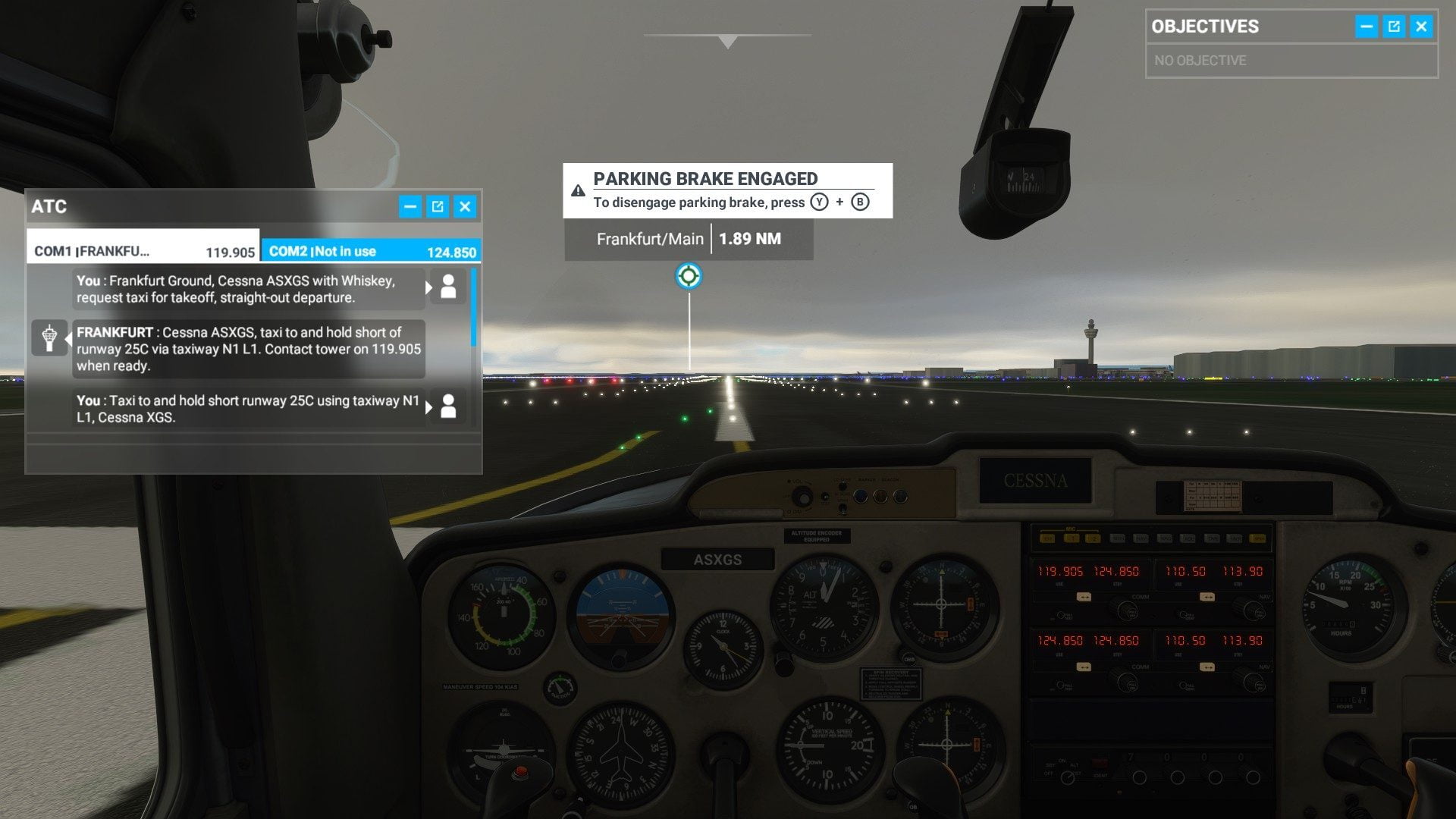
In reality, the pilot configures the frequency (FM band, e.g. 121.9MHz) for the corresponding mission phase on the radio. The exact airport frequencies can be found on the airport charts. You could also select a default frequency from the “Air Traffic Control” menu. The usual sequence for a complete mission from the departure airport to the arrival airport usually looks like this:
- ATIS Obtain airport information (current weather conditions, current wind direction, currently free/blocked departure routes)
- Delivery Obtain departure approval (flight plan approval) from the departure airport
- Ground Obtaining clearance for pushback, start-up of engines and taxiway (TAXI)
- Tower Obtain clearance (Cleared for Take-Off) from the departure airport
- Control Obtain airspace clearance (flight path and altitude) – (changes during flight, if you fly through several airspaces)
- Approach Obtain approach path clearance for approach airport
- Tower Obtain landing clearance (Cleared for Landing) for approach airport
- Ground Obtain the taxiing clearance (TAXI) to the docking area of the airport
All air traffic control frequencies, with the exception of Control, are airport-specific. Frankfurt (EDDF), for example, has its own ATIS, delivery, ground and tower frequencies. Control controls the airspace between the departure and arrival airports and monitors your flight path (course) and altitude.
Some airports do not separate Delivery and Ground in every case. The individual tasks are sometimes handled by one and the same frequency. In extreme cases – especially at smaller airports – the tower takes over all air traffic control areas of the plane.
“Real” Pilot Job: Flying in a Virtual Airline
In virtual flying, you join a virtual airline online and climb the career ladder by completing numerous virtual flights on your PC – all the way up to the flight captain! As a virtual pilot, you complete virtual flights and are supported by an air traffic control system which consists of player-controlled virtual air traffic controllers, who either communicate with you in English via voice chat or alternatively via text windows.
Examples for virtual flight networks are the International Virtual Aviation Organization IVAO or the International Online Flying Network VATSIM. Both organizations have German offshoots and will be surely happy to welcome interested pilots.
Translation by: Dennis Anjuschin
No related articles found.

